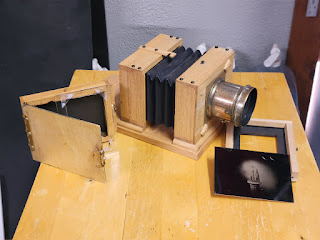A tribute camera build: "The Stockwell View Camera"
Original and only known example of the Stockwell Camera.
Using the then-popular tailboard design with a short bellows, the handsome camera had a swing-out focusing frame that would be replaced by a holder with a quarter-sized plate (3.25" x 4.25") extracted from an auxiliary magazine/loader. The ungainly design favored mainly landscape orientation, but the front featured a small recess for interchangeable lens boards. Overall, it is an attractive, interesting, and useful build project.
The focusing back swings over the locking nut by means of a curved cutout.
I forewent the idea of reproducing the magazine since I intended to use the camera mainly for wet plates. Using images from the sole article on the web about this camera, I conceived a likely plan, and built a first prototype out of cedar with paper bellows. After confirming the measurements and cut list, I built a second prototype out of red oak (using door thresholds from a hardware store) and built a proper set of bellows (using car seat fabric which is pretty but way too thick).
This camera works well with the wet plate holders I adapted into the architecture. One holder accepts quarter-plate media directly while the other adapter allows use of a 6x9cm filmpack adapter loaded with a wet plate insert for bon-ton sized images. This Rube Goldberg gadget actually works, but only in landscape mode (portraits not so easily made).
Portrait orientation is... awkward.
I have precut some walnut and some maple for future iterations after I finish some Spring cleaning and home projects.






Comments
Post a Comment